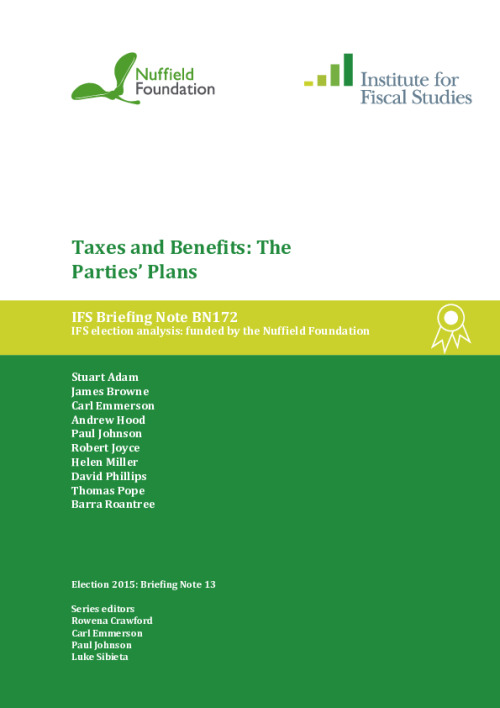Click here to download the Executive Summary only.
The last five years have seen considerable policy activity in the tax and benefit sphere: in total, some £56 billion per year of giveaways and £89 billion per year of takeaways by 2015–16. Most of the main tax reforms have simply changed rates or thresholds within current structures – the increase in the main rate of VAT, cuts to the main corporation tax rate, real cuts to the rates of fuel duties and the big increase in the income tax personal allowance being the most important. Only for pensions and savings has there been a significant reshaping in terms of what is taxed and what is not. Changes to benefits have mostly been straightforward cuts in generosity, with more significant structural reform coming in the next parliament – the introduction of the single tier pension, the introduction of universal credit and the replacement of disability living allowance (DLA) with personal independence payment (PIP).
As for what is to come, there are important areas of agreement between the main UK parties. There is apparently a huge amount of money to be extracted through a clampdown on tax avoidance (mysteriously missed by all previous clampdowns). There is yet more money to be extracted from those on very high incomes saving in a private pension. The main rates of income tax, NICs and VAT will not be increased. The ‘triple lock’ on indexation of the basic state pension will remain and most pensioner benefits will be protected. There is also a shared lack of any attempt to paint a coherent strategy for tax reform, a shared desire to impose further, often absurd, complications to the tax system, and a shared lack of willingness to set out specific benefit measures which chime with the parties’ rhetoric. On that latter point, on the one hand the Conservatives have spent two years promising substantial additional benefit cuts of £12 billion a year whilst failing to come up with more than 10% of that figure in actual cuts. On the other hand Labour’s promised ‘toughness’ involves reducing spending by almost nothing by taking winter fuel payments from the small number of pensioners subject to the higher rates of income tax, and, most likely, literally nothing by limiting the uprating of child benefit rates.
There are significant differences between the parties too. The Conservatives are promising significant income tax cuts through further increases in the personal allowance and an increase in the point at which higher rate tax becomes payable. The first of these ambitions is shared by the Liberal Democrats while the Labour manifesto is silent on these points. Labour and the Liberal Democrats (and the SNP) share a desire to impose a ‘mansion tax’, not a policy adopted by the Conservatives. Labour (and the SNP) would return the top rate of income tax to 50%. The Conservatives are alone in saying they would seek big cuts in benefit spending and generosity.
In this summary we look at the main proposed changes to income tax, mansion tax, other taxes, and benefits in turn, with a particular focus on Labour and the Conservatives. The main body of this document then examines most of the specific tax and benefit policies of Labour, Conservatives and Liberal Democrats in some detail.
Watch a recording of the briefing at which the note was launched here:

















